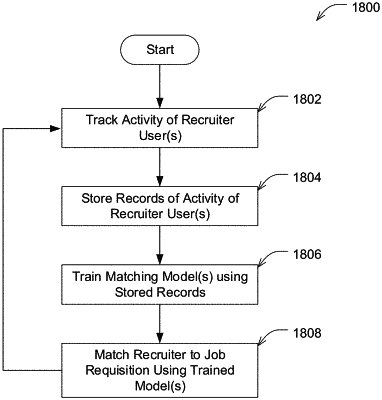| CPC G06Q 10/063112 (2013.01) [G06Q 10/1053 (2013.01)] | 34 Claims |

|
1. A computer-implemented method comprising:
tracking, by at least one processor, activity of a plurality of recruiter users of a talent exchange system, the activity comprising actions performed in the talent exchange system by the plurality of recruiter users in placing candidates for job requisitions;
storing, by the at least one processor., in a database, records of the activity of the plurality of recruiter users;
training at least one first machine learning model, by the at least one processor, using at least a first portion of the records of the activity of the plurality of recruiter users and information in one or more job requisitions for which the plurality of recruiter users have placed candidates, the at least one first machine learning model comprising at least one neural network, wherein training the at least one first machine learning model comprises iteratively training the at least one neural network using back propagation, based on feedback of predicted value of the at least one neural network, and wherein the at least one first machine learning model is configured to output a plurality of numerical values using a job requisition, wherein the plurality of numerical values are each associated with a respective one of a set of job categories;
training at least one second machine learning model, by the at least one processor, using at least a second portion of the records of the activity of the plurality of recruiter users, the second portion of the records of the activity associated with one or more job requisitions for which the plurality of recruiter users have placed candidates, the at least one second machine learning model configured to output a measure of compatibility between a recruiter user and a job requisition;
obtaining at least one job category associated with a first job requisition using the trained at least one first machine learning model configured to be provided with the first job requisition and output a plurality of output numerical values using the first job requisition, each output numerical value associated with a respective one of the set of job categories, wherein obtaining the at least one job category is based on the plurality of output numerical values outputted by the trained at least one first machine learning model;
determining, by the at least one processor, a portion of a record of activity of a first recruiter user associated with the at least one job category;
obtaining, by the at least one processor, a first measure of compatibility associated with the at least one job category between the first recruiter user and the first job requisition from the trained at least one second machine learning model, wherein the trained at least one second machine learning model is provided with at least the portion of the record of activity of the first recruiter associated with the at least one job category and the first job requisition to output the first measure of compatibility;
determining whether the first measure of compatibility between the first recruiter user and the first job requisition exceeds a threshold;
in response to determining that the first measure of compatibility between the first recruiter user and the first job requisition exceeds the threshold, performing one or more operations comprising:
recommending, within a user interface of a talent platform associated with a hiring user that submitted the first job requisition, the first recruiter user in the at least one job category to the hiring user that submitted the first job requisition; or
recommending, within a user interface of a talent platform associated with a first recruiter user, the first job requisition to the first recruiter user; and
matching a candidate submitted by the first recruiter user to the first job requisition based on the first measure of compatibility, wherein the first measure of compatibility comprises a numerical score indicative of a likelihood that the first recruiter user will place a suitable candidate for the first job requisition.
|